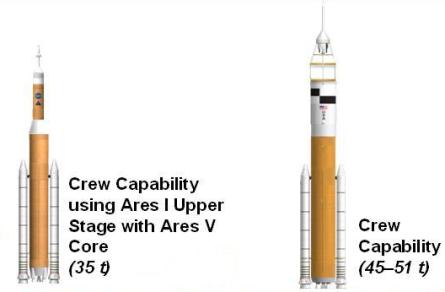On 21 August NASA’s Orion crew exploration vehicle’s (CEV) preliminary design review starts and four-days later the first test firing of a solid rocket booster for its launcher, the Ares I, occurs but this week US president Barack Obama’s administration will be presented with a set of choices that could see both cancelled.
The US Review of human space flight plans committee [see box below] will give Obama’s administration these choices, with which the president will decide whether the US explores beyond low Earth orbit.
Cancellation of Orion and Ares I, the crew launch vehicle (CLV), would come after four-years of work and about $10 billion spent on the Moon return Constellation programme that has overseen their development since 2005, and which would also be ended.
In competition with Constellation for Moon return are alternative proposals from within NASA, the Space Shuttle-derived Heavy Lift Vehicle (HLV), and from industry the proposed evolution of the United Launch Alliance’s Evolved Expendable Launch Vehicles, such as the Atlas V, and finally the Jupiter rockets from an independent team called Direct.
While these alternatives’ appearences have been few, Constellation personnel have given at least 10 presentations and indicated in them that NASA could change its Ares rockets.
At the 29 July Huntsville, Alabama meeting Constellation’s Ares V cargo launch vehicle (CaLV) integration manager Steve Creech showed five variations on the baseline designs for Ares I and CaLV, which is to launch the Earth departure stage and Altair lunar lander.
Two of them show an Ares V that uses a 5m (16.3ft)-diamater Ares I upper stage, a design previously referred to by NASA as Ares IV, and a version called Ares V Light, where the 10m-diameter upper stage only supports an Orion or a lunar lander.
 |
|---|
Above: This shows two variants of NASA's Ares V cargo launch vehicle, presented at the 29 July 2009 meeting of the Review of US human space flight plans commitee |
NASA’s HLV could deliver that but such a Moon architecture would require three launches, one for the Orion, perhaps still on Ares I, and two HLVs or Ares V Lights.
However NASA’s Constellation programme manager Jeffrey Hanley told Flight International that “The latest [Ares] variants are parametric exercises, no ‘design’ work has been done... the [slide from the 29 July presentation] is as much as exists at this point without a full design cycle to understand the integrated performance for the mission.”
One defnite change is reducing Orion’s crew complement from six to four. “Four crew is now the baseline. We can carry 3,500lb (1,590kg) more cargo to Internatonal Space Station,” says Larry Price, deputy Orion project manager for NASA’s CEV prime contractor Lockheed Martin.
The change emerged from a 2008 study that examined whether Constellation could be accelerated and recommended a content review to understand how the programme could adapt to the funding reality that had hampered its work - this review will continue until 2010 unless Obama cancels Constellation.
Meanwhile the US government’s technical analysis organisation, Aerospace Corporation, told the 29 July meeting that a combination of technical challenges, funding hurdles and ISS life extension to 2020 could see the Orion-Ares first flight up to four-years later than its March 2015 target.
Augustine committee member Bohdan Bejmuk, a former Boeing Space Shuttle orbiter programme director and now chairman of Constellation’s Standing Review Board, told the 29 July meeting, “[Constellation’s] budget problems are bigger than [its] technical problems.”
While advising that an analysis of launch alternatives should take months and not the three-weeks it has had, Aerospace advised that commercial rockets, meaning the EELVs or Space Exploration Technologies’ Dragon-Falcon launch system, could take as long as Constellation.
At the same meeting Bejmuk expressed doubt over the effectiveness of the alternatives, referring to Atlas 5 as a vehicle that, while relatively lower cost, had questionable performance margins. In Bejmuk’s view “if you change you better change to something so much better that it is overwhelming.”
| The US Review of human spaceflight plans committee, created in May, is led by former Lockheed Martin chairman Norman Augustine. It has held six public meetings since its first on 17 June, with the last due on 12 August, with locations including Huntsville, Alabama and Washington DC for the final one. It also undertook NASA site visits. On 14 August it is due to present its findings to Obama's director of the president's office of science and technology policy and NASA administrator Charles Bolden. Its report does not have recommendations, only options. |
|---|
Source: Flight International


























